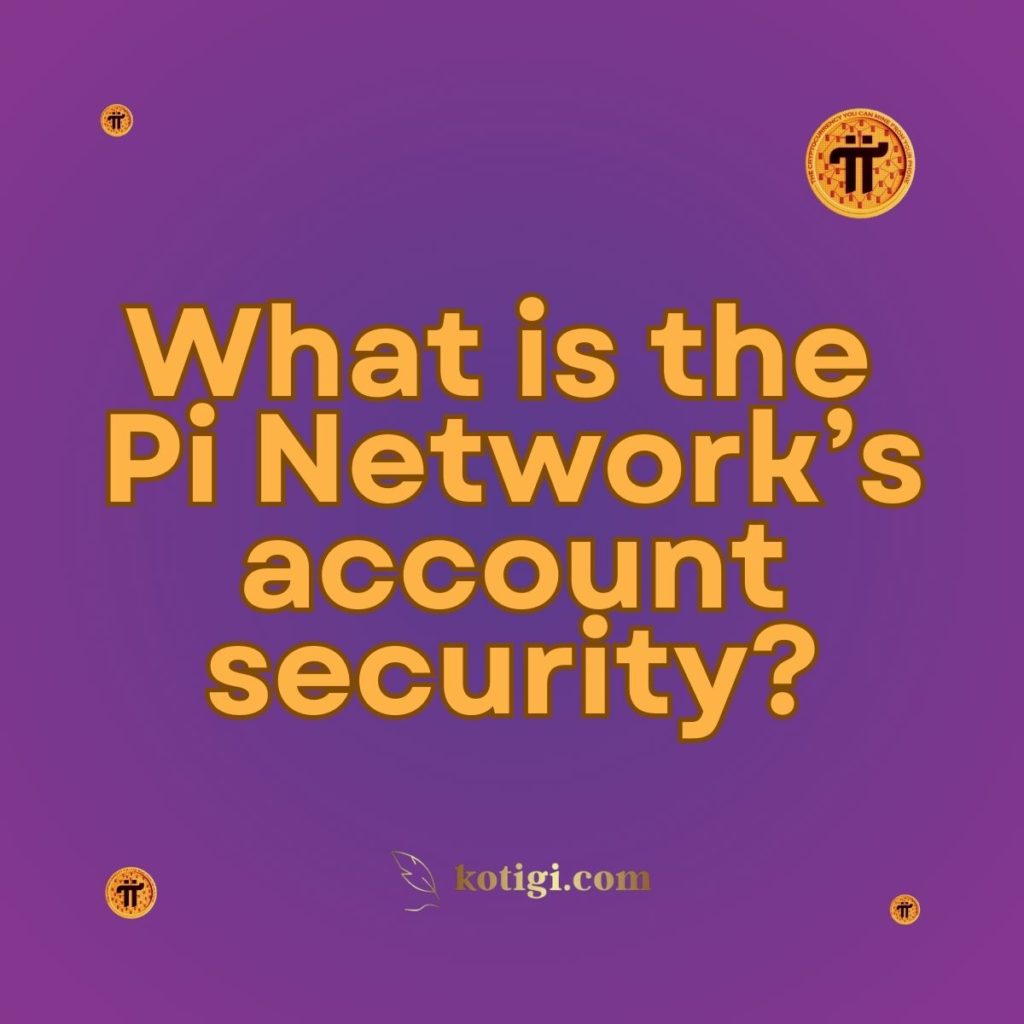
What is the Pi Network’s account security?
Pi Network provides a comprehensive account security system through encryption, two-factor authentication (2FA), and decentralized architecture to ensure the safety of user data and assets. The platform continuously enhances its security features, preventing unauthorized access and ensuring users can manage their accounts securely. For more details, check the Pi Network https://minepi.com/blog/pi-account-safety/
Introduction
In a world where data breaches and cyberattacks are becoming more frequent, the security of digital platforms, especially in the cryptocurrency space, is more important than ever. Pi Network has designed its security infrastructure to protect user accounts and assets from potential threats while maintaining ease of use. Through various security measures like two-factor authentication (2FA), encrypted communications, and decentralized systems, Pi Network provides a secure environment for its users to manage their accounts and engage in transactions.
This article will explore the different security features of the Pi Network and how users can take full advantage of these measures to safeguard their accounts.
Key Features of Pi Network’s Account Security
Encryption Technology
At the core of Pi Network’s security architecture is strong encryption technology. All user data, including account details, transaction information, and personal identifiers, is encrypted both at rest and in transit. This ensures that even if data were intercepted, it would be unreadable to unauthorized parties.
Encryption plays a critical role in safeguarding user information from external threats like hackers, as well as preventing internal leaks or misuse of data. Pi Network employs industry-standard encryption protocols, which not only protect the data but also ensure that transactions made on the network remain private and secure.
Two-Factor Authentication (2FA)
Two-factor authentication (2FA) is one of the primary methods Pi Network uses to enhance the security of user accounts. By enabling 2FA, users add an additional layer of protection beyond just their password. Every time they log in, they are required to provide a one-time code generated by an authentication app or sent via SMS.
This feature significantly reduces the risk of unauthorized access, even if someone manages to steal the user’s password. By requiring an additional code that is accessible only through the user’s mobile device, Pi Network ensures that account security is not compromised by a single point of failure.
Decentralized Architecture
Pi Network is built on a decentralized model, meaning there is no central server vulnerable to large-scale attacks. Decentralization distributes the network across many nodes, making it far more difficult for hackers to compromise the system. This structure enhances the security of user accounts and digital assets by reducing the chances of a single point of failure.
Moreover, decentralization also adds a layer of privacy for users. Since the network is spread across multiple independent nodes, user data is less accessible and more difficult to target, further improving overall security.
Protecting User Data and Privacy
Secure User Authentication
The Pi Network employs secure user authentication protocols to ensure that only authorized individuals can access accounts. This involves standard login credentials like a password, combined with additional features like 2FA to enhance protection. Passwords are hashed and stored securely, meaning they are not stored in plain text, which further minimizes the risk of breaches.
Pi Network’s focus on user authentication also includes regular updates to security protocols, ensuring they remain effective against new and evolving threats.
KYC (Know Your Customer) Verification
To ensure the authenticity of users, Pi Network implements Know Your Customer (KYC) verification for account holders. This process involves submitting official identification documents, which are then verified by the platform. KYC ensures that users are real individuals, not bots or fraudulent actors, enhancing the trust and security within the network.
KYC also helps prevent fraudulent activities, such as the creation of multiple fake accounts or attempts to manipulate the Pi ecosystem. By requiring KYC for certain functions, Pi Network ensures that the platform remains a safe space for legitimate users to interact and conduct transactions.
Monitoring and Detection Systems
Pi Network also employs advanced monitoring and detection systems to track any unusual or potentially malicious activity on user accounts. These systems can flag suspicious behaviors such as multiple failed login attempts, account access from unfamiliar devices or locations, and high-frequency transactions that fall outside normal patterns.
In cases where such activity is detected, Pi Network temporarily locks the account to prevent unauthorized access and notifies the user. This gives users time to review their account activity and ensure their information remains secure.
Best Practices for Account Security on Pi Network
Regularly Update Your Password
One of the simplest but most effective ways to maintain the security of your Pi Network account is to regularly update your password. A strong password should be a combination of upper and lower-case letters, numbers, and special characters. It’s also important to avoid reusing passwords across multiple platforms to prevent a breach in one system from affecting others.
Pi Network encourages users to periodically update their passwords and provides an easy password reset option in case they forget it. Regularly changing your password reduces the risk of unauthorized access, especially in case of data leaks from other platforms.
Enable Two-Factor Authentication (2FA)
As mentioned earlier, enabling 2FA is one of the most effective ways to secure your Pi Network account. This additional security layer ensures that even if someone gains access to your password, they won’t be able to access your account without the 2FA code.
Users should enable 2FA in their account settings and keep their authentication app or SMS verification methods secure. Pi Network strongly recommends this feature for all users, especially those who hold significant amounts of Pi.
Avoid Phishing Attempts
Phishing is a common tactic used by cybercriminals to steal sensitive information like login credentials. Pi Network advises users to be cautious of any unsolicited emails, messages, or links that ask for account details. Users should only log in to their Pi Network account through official apps or verified URLs to avoid falling victim to phishing attempts.
Moreover, Pi Network does not request sensitive information through informal channels such as social media or instant messaging. Being vigilant and recognizing phishing attempts is a key part of keeping your account secure.
Secure Your Device
Ensuring that the device you use to access your Pi Network account is secure is another important factor in account protection. Regularly updating your device’s operating system and installing security patches helps prevent vulnerabilities from being exploited by attackers. It’s also wise to install trusted security software that can detect and block potential malware and viruses.
For mobile devices, using a screen lock and encrypting your device can add an extra layer of protection, ensuring that even if your device is lost or stolen, unauthorized individuals won’t be able to access your Pi Network account.
The Role of Pi Network’s Community in Security
Security isn’t just about technology; it’s also about the behavior of the community using the platform. Pi Network fosters a strong community ethos where users are encouraged to report any suspicious activities they notice, such as phishing scams or fraudulent accounts. This collective vigilance enhances the security of the entire platform.
By promoting security awareness within its community, Pi Network ensures that users are part of the solution, creating a more resilient and secure ecosystem. Regular updates from the Pi Core Team also keep users informed about new threats and best practices to follow for account protection.
Conclusion
Pi Network’s account security framework is robust, utilizing advanced technologies like encryption, two-factor authentication, and decentralized architecture to protect users’ accounts and data. The network offers various tools and guidelines to help users enhance their account security, from enabling 2FA to following best practices for secure login and password management.
By integrating both technology and community vigilance, Pi Network ensures a secure and trustworthy environment for its users. For those looking to participate in the Pi ecosystem, understanding and applying these security measures is key to protecting both their accounts and their assets.
Key Takeaways
- Pi Network uses encryption, two-factor authentication (2FA), and a decentralized model to ensure account security.
- Secure user authentication, including KYC verification, helps prevent unauthorized access.
- Users should regularly update passwords, enable 2FA, and avoid phishing scams to maintain account security.
- A secure device and community vigilance are essential components of a secure account.
- The Pi Network community plays a vital role in reporting suspicious activity, contributing to the platform’s overall security.





